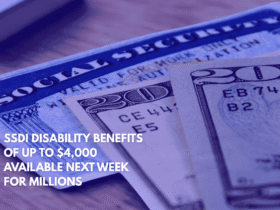Social Security Income (SSI) recipients experienced something unusual in May 2025. Couples receiving SSI benefits saw double deposits, with payments totaling up to $2,900. This was because the Social Security Administration (SSA) moved the June payment to May 30 due to the first of June falling on a Sunday.
However, with no payments scheduled for June, the next payment will be in July 2025. Let’s dive into what this means for SSI recipients and what changes are expected in the coming months.
Why Were Payments Doubled in May?
In May 2025, couples who receive SSI benefits saw a larger-than-usual payment. The total was $2,900 because the SSA made an early payment for June on May 30. Normally, SSI payments are made once a month, but when the first day of the month falls on a weekend or holiday, SSA moves the payment to the last business day of the previous month.
Since June 1, 2025, was a Sunday, SSA advanced the payment to May 30. As a result, there were no SSI payments in June 2025, and recipients will have to wait until July 2025 for their next disbursement.
How Much Will SSI Payments Be in July 2025?
For July 2025, SSI payments will be based on the usual monthly schedule. The maximum payment for an individual will be around $967, while couples can receive up to $1,450. These amounts are part of the federal SSI payment structure and are adjusted annually based on the Cost-of-Living Adjustment (COLA).
In addition to the federal SSI payment, some states provide extra money called supplemental SSI benefits. These vary from state to state and help increase the total SSI amount a person can receive.

Which States Provide SSI Supplemental Benefits?
In 2025, 44 states (along with Washington, D.C.) offer supplemental benefits to SSI recipients, increasing the amount they receive. Here are the states that provide additional funds:
- Alabama, Alaska, California, Colorado, Connecticut, Delaware, District of Columbia, Florida, Georgia, Hawaii, Idaho, Illinois, Indiana, Iowa, Kansas, Kentucky, Louisiana, Maine, Maryland, Massachusetts, Michigan, Minnesota, Missouri, Montana, Nebraska, Nevada, New Hampshire, New Jersey, New Mexico, New York, North Carolina, Ohio, Oklahoma, Oregon, Pennsylvania, Rhode Island, South Carolina, South Dakota, Texas, Utah, Vermont, Virginia, Washington, Wisconsin, Wyoming.
However, five states do not offer extra payments:
- Arizona, Arkansas, Mississippi, North Dakota, Tennessee, and West Virginia.
How Can You Qualify for SSI Benefits?
If you want to apply for SSI benefits, there are several key requirements you must meet:
- Age or Disability: You must be 65 or older, blind, or disabled.
- Income: Your income must be below the Federal Benefit Rate (FBR), which is projected to be $967 per month for individuals and $1,450 per month for couples in 2025. This includes wages, Social Security benefits, and pensions.
- Assets (Resources): You can have very few assets. The limit is $2,000 for individuals and $3,000 for couples. Things like your primary home, one car, personal belongings, and some burial funds do not count as assets.
- U.S. Citizenship or Qualified Non-Citizen Status: You must be a U.S. citizen or a qualified non-citizen and live in one of the 50 states, Washington, D.C., or the Northern Mariana Islands.
Once you meet these requirements, you need to apply with the Social Security Administration (SSA) and provide proof of your age, disability or blindness, income, assets, and citizenship/residency.











Leave a Reply